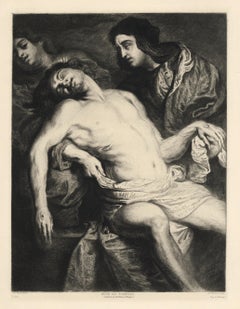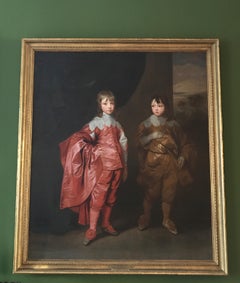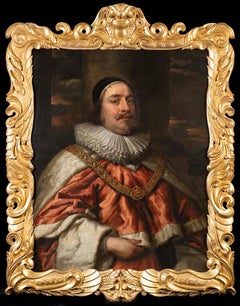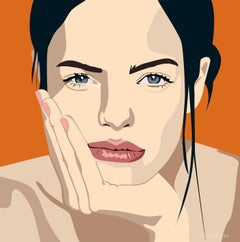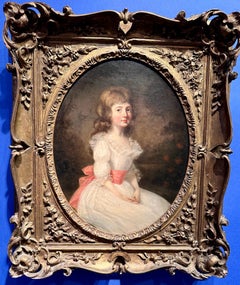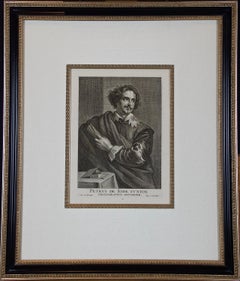(After) Anthony Van Dyck Art
Dutch, 1599-1641
Sir Anthony van Dyck (22 March 1599 – 9 December 1641) was a Flemish Baroque artist who became the leading court painter for Charles I of England. Sir Anthony Van Dyck was born in the Netherlands and painted from an early age becoming a successful independent painter in his late teens, and a master in the Antwerp Guild in 1618. He painted in the studio of Peter Paul Rubens who became a major influence on his work. Van Dyck worked in London for some months in 1621, then returned to Flanders and travelled to Italy, where he stayed until 1627, mostly in Genoa. He spent five years in Flanders after his return from Italy, and was court painter for the archduchess Isabella, Habsburg Governor of Flanders. In 1632 he returned to London to become the main court painter to Charles I of England.
After Holbein, van Dyck and his contemporary Diego Valezquez were the first painters of pre-eminent to work mainly as court portraitists, revolutionising the genre. Van Dyck is best known for his portraits of the royals and aristocracy, most notably Charles I, and his family and associates. Van Dyck widely influenced English portrait painting for the next 150 years. His portrait style changed considerably between the different countries he worked in, culminating in the relaxed elegance of his last English period. His influence extends into the modern period. During his lifetime, Charles I granted him a knighthood, and after his death Van Dyck was buried in St Paul’s Cathedral, an indication of his high standing at the time of his death.(Biography provided by Duchess Fine Art & Antiques)
to
3
1
1
4
2
1
1
Overall Height
to
Overall Width
to
2
2
2
2
1
1
3
1
4
6,934
3,279
2,514
1,213
2
2
1
1
1
Artist: (After) Anthony Van Dyck
"Mise au Tombeau" etching
By (After) Anthony Van Dyck
Located in Henderson, NV
Medium: etching (after the painting). Etched by Charles Albert Waltner after Van Dyck. This impression on laid paper was printed by A. Salmon and published in Paris for "L'Art" circa...
Category
1870s (After) Anthony Van Dyck Art
Materials
Etching
Anthony van Dyck, Engraving Ernest de Mansfeld, c. 1654, Portrait, Iconographie
By (After) Anthony Van Dyck
Located in Greven, DE
A wonderfully detailed and charismatic portrait, this exquisite work illustrates the technical mastery and artistic vision of Van Dyck. Ernest de Mansfeld's stately yet approachable expression reflects Van Dyck's refined ability to comfort and relax his subjects, resulting in a realistic and acute portrait. Ernest de Mansfeld was a German military commander during the early years of the Thirty Years War. Donning his armor and an ornate, lace collar, de Mansfeld appears as a strong commander. Without a hint of a smile, he calmly gazes out, the definition of cool and collected. Van Dyck accurately captures the sense that de Mansfeld is a man who takes his job seriously, a man worthy of commanding an army in battle.
This portrait is a Mauquoy-Hendrickx State II (of II), engraved by Robertus van Voerst in collaboration with Anthony van Dyck (Antwerp, 1559 - London, 1641) as part of his Iconographie series of engraved portraits of famous people...
Category
17th Century Baroque (After) Anthony Van Dyck Art
Materials
Engraving
Double Portrait Oil Painting Brothers George, 2nd Duke Buckingham & Lord Francis
By (After) Anthony Van Dyck
Located in London, GB
Aftrer Anthony VAN DYCK - maybe Studio (1599, Antwerp – 1641, London) Flemish
Double Portrait of George Villiers, 2nd Duke of Buckingham (1628-1687) & Lord Francis Villiers (1629-1648)
Oil on Canvas
170 x 147 cm
Anthony Van Dyck (1599-1641)
No painter has done more to define an era than Anthony van Dyck. He spent only seven and a half years of his short life (1599- 1641) in England. He grew up in Antwerp, where his precocious talent was recognised by Peter Paul Rubens, the greatest painter of his age. He worked in Rubens’s studio and imitated his style as a religious artist, painting biblical scenes redolent of the lush piety of the counter-reformation. But soon he was on the move. In 1620, he visited London for a few months, long enough to paint a history picture, The Continence of Scipio, for the royal favourite, George Villiers, Marquess of Buckingham, and a portrait of his other English patron, the great art collector, Thomas Howard, 2nd Earl of Arundel.
After a stint in Italy, making imposing portraits of the wealthy aristocracy and sketching and copying works by Titian, he returned to the Spanish Netherlands in 1627, becoming court artist to Archduchess Isabella before departing for The Hague in 1631 to paint the Dutch ruler Frederick Henry, Prince of Orange. Charles I’s invitation in 1632 led Van Dyck back to London where he was knighted, paid an annual salary of £200 and installed in a house in Blackfriars with a special jetty at which the royal barge might tie up when the King was visiting his studio. By this time Van Dyck was recognised as the leading court painter in Europe, with Velazquez at the court of Philip IV of Spain his only rival. He also excelled as a superbly observant painter of children and dogs.
Van Dyck’s notoriety in depicting children led to the introduction of groups of children without their parents as a new genre into English painting (amongst other new genres).
For the next 300 years, Van Dyck was the major influence on English portraiture. Nearly all the great 18th Century portraitists, from Pompeo Batoni and Allan Ramsay to Thomas Gainsborough and Joshua Reynolds, copied Van Dyck’s costumes, poses and compositions.
George Duke of Buckingham & his brother Francis Villiers
Painted in 1635, this double portrait was originally commissioned by Charles I, who raised the two brothers after their father, George Villiers, was assassinated in 1628. Together with their sister, Lady Mary Villiers, they enjoyed the King’s favour absolutely. Francis whose absolute ‘inimitable handsomeness’ was noted by Marvell (who was killed in a skirmish near Kingston upon Thames). The young duke who commanded a regiment of horse at the Battle of Worcester, remained closely associated with Charles II, held a number of high offices after the Restoration and was one of the most cynical and brilliant members of the King’s entourage, immortalised as ‘Zimri’ in Dryden’s Absalom and Achitopbel. As a young man he had sold his father’s great collection of pictures in the Spanish Netherlands, many of them to the Archduke Leopold Willhelm.
Painted for Charles I and placed near the portrait of their sister in the Gallery at St James’ Palace. The handling of both costumes is very rich, and the heads are very carefully and sensitively worked. That of the younger boy in particular is more solidly built up than the lower part of the figure. A preparatory drawing for the younger boy is in the British Museum.
There are copies at, e.g., Highclere Castle...
Category
17th Century Old Masters (After) Anthony Van Dyck Art
Materials
Oil
Portrait of Sir Edward Littleton, First Baron Lyttleton, Old Masters Oil
By (After) Anthony Van Dyck
Located in London, GB
After Sir Anthony van Dyck (1599-1641)
Portrait of Sir Edward Lord Littleton, First Baron Lyttleton (1589-1645)
Oil on canvas
Image size: 96 by 76 cm
Hand carved auricular frame
Sir Edward Littleton was Solicitor-General to Charles I, 1634-40; Chief Justice of Common Pleas, January 1640-January 1641; Lord Keeper, 1641-45.
Painted in his robes, and wearing the chain of office...
Category
17th Century Old Masters (After) Anthony Van Dyck Art
Materials
Oil, Canvas
Related Items
Orit Fuchs: Vivid 4 - Giclee print on canvas female figure painting. 29.5/29.5”
By Orit Fuchs
Located in Tel Aviv, IL
Orit Fuchs lives and works in Tel Aviv, a storyteller with a deep, pure, and unquenchable appetite for artistic self-expression. Her medium spans the gamut - sculptures, pa...
Category
2010s Pop Art (After) Anthony Van Dyck Art
Materials
Giclée
18th century Portrait of a young girl, Miss Cator in a landscape, white dress
By John Russell
Located in Woodbury, CT
Portrait of a young British Girl, in her white dress with Pink Sash.
Choosing to acquire an 18th-century portrait of a young girl by English artist John Russell is an opportunity to...
Category
1780s Old Masters (After) Anthony Van Dyck Art
Materials
Canvas, Oil
Free Shipping
H 21 in W 18 in
Portrait of a Young Gentleman and Pet Dog c.1680, Antique oil on Canvas Painting
By (Circle of) Mary Beale
Located in London, GB
The portrait genre was valued particularly highly in English society. Neither landscapes nor allegorical pictures were ever priced so highly at exhibitions and in the trade as depictions of people, from the highest aristocracy to scholars, writers, poets and statesmen. This charming portrait, presented by Titan Fine Art, of a fashionable young gentleman and his faithful pet is an excellent example of 17th century child portraiture in England. There is a remarkable beauty and sensitivity to the portrait. The face, particularly well rendered, has captured the character of this young man – both charming and at the same time mischievous.
Only the playful attention of a small dog suggests anything less than patrician dignity. Symbolism was important in portraiture and it provided a pointed and aspirational narrative that would not have been lost on contemporary viewers. For example, the presence of the dog, which was likely the boy’s pet, is at once a charming pictorial device and also a clear allusion to fidelity, trust and loyalty.
The hairstyle and the attire, notably the type of cravat with the blue ribbon, help to date this portrait to between 1670 to 1685. Until the late eighteenth century children were dressed as adults - boys were dressed like men in breeches, vests, and coats between four and seven years of age. The expensive lace is an indication to his family’s wealth.
Held in a good quality and condition antique gilded frame.
Born in Suffolk, Mary Beale, nee Cradock (1633-1699) was employed by many of the most distinguished persons of her time including nobility, landed gentry, and clergymen. Technically accomplished, her paintings are noteworthy for their honest and sympathetic portrayal. In 1651 she married Charles Beale...
Category
17th Century Old Masters (After) Anthony Van Dyck Art
Materials
Canvas, Oil
H 35.44 in W 32.29 in D 3.15 in
Male and female portrait, both in silk kimono, possibly textile dealers
By Christoffel Lubieniecki
Located in Amsterdam, NL
CHRISTOFFEL LUBIENIECKI (1659-1729)
Pair of portraits of a gentleman and a lady, both in silk kimono, before a country house (circa 1680)
Indistinctly signed “C.......” on a box under the man’s left hand
Oil on canvas, 79.5 x 67 cm each
Both sitters are portrayed wearing a silk “Japanese” coat. During the second half of the seventeenth the Japanese silk coat, an adapted Japanese kimono, became a real vogue in the Dutch elite. The exclusive Dutch trade contacts with Japan can explain the popularity of the kimono-style silk coats in the Netherlands. Everybody who could afford one, dressed in such a fashionable and comfortable coat and, like the present sitters, some proud owners had themselves portrayed in a “Japanese” coat often together with an oriental carpet to underline their standing and international connections. These portraits are the work of the Polish-born portraitist Christoffel Lubieniecki (also known as Lubienitski, Lubinitski or Lubiniecki)
Lubieniecki was first trained in Hamburg under Julian Stuhr and after 1675 in Amsterdam under Adriaen Backer and Gerard de Lairesse. He specialized in landscapes, generally of an Italianate character, and in portraits. The loving execution of these contented burghers, enjoying the garden vistas of their country house, places him alongside Amsterdam portraitists such as Constantijn Netscher and Michiel van Musscher...
Category
1680s Old Masters (After) Anthony Van Dyck Art
Materials
Oil, Canvas
Free Shipping
H 31.34 in W 26.38 in D 1.97 in
18th century portrait of the painter Nathaniel Dance
Located in London, GB
Collections:
Robert Gallon (1845-1925);
Private Collection, UK.
Oil on canvas laid down on panel
Framed dimensions: 11.5 x 10 inches
This highly engaging, previously unpublished portrait by Johan...
Category
18th Century Old Masters (After) Anthony Van Dyck Art
Materials
Oil, Wood Panel, Canvas
18th Century French Portrait of Mysterious Man Oil on Canvas for restoration
Located in Cirencester, Gloucestershire
Portrait of a Gentleman
French School, 18th century
oil on canvas, unframed
canvas : 25 x 20 inches
provenance: private collection, France
condition: the painting is in sound conditi...
Category
18th Century Old Masters (After) Anthony Van Dyck Art
Materials
Oil
Portrait of Lady Caroline Price
By George Romney
Located in Miami, FL
DESCRIPTION: Perhaps the best Romney in private hands. If Vogue Magazine existed in the late 18th century, this image of Lady Caroline Price would be ...
Category
1970s Old Masters (After) Anthony Van Dyck Art
Materials
Canvas, Oil
The Annunciation to the Shepherds - Dutch 17thC art religious oil painting
Located in London, GB
This wonderful 17th century Old Master religious oil painting is attributed to Dutch Golden Age artist Benjamin Gerritsz Cuyp. Painted circa 1633 it is entitled The Annunciation to t...
Category
17th Century Old Masters (After) Anthony Van Dyck Art
Materials
Oil
Huge 18th Century English Oil Aristocratic Portrait of a Gentleman Standing
Located in Cirencester, Gloucestershire
Portrait of an Aristocratic Gentleman
British artist, first half 18th century
oil on canvas, unframed
canvas: 50 x 40 inches
provenance: private collection, Dorset, England
condition...
Category
18th Century Old Masters (After) Anthony Van Dyck Art
Materials
Oil, Canvas
19th century portrait painted in St Petersburg in 1819
Located in London, GB
Signed, inscribed and dated, lower right:
'Geo Dawe RA St Petersburgh 1819', also signed
with initials, lower centre: 'G D RA'; and signed and inscribed verso:
'Geo Dawe RA Pinxit 1819 St Petersburgh';
Also inscribed on the stretcher by Cornelius Varley with varnishing instructions.
Collections:
Private collection, UK, 2010
Literature:
Galina Andreeva Geniuses of War, Weal and Beauty: George Dawe...
Category
19th Century Old Masters (After) Anthony Van Dyck Art
Materials
Oil, Canvas
fern-butterfly effect f-1
By Seiko Tachibana
Located in Palm Springs, CA
Medium: intaglio
Year: 2015
Signed Artist Proof from the edition of 25
Image Size: 7.5 x 6 inches
Paper Size: 15 x 11 inches
Signed and numbered by the artist.
Seiko Tachibana's...
Category
2010s Abstract Geometric (After) Anthony Van Dyck Art
Materials
Etching, Aquatint
Portrait of Lady, Grace Saunderson, Viscountess Castleton Oil on canvas Painting
By Studio of Sir Peter Lely
Located in London, GB
Portrait of Grace Saunderson, Viscountess Castleton (1635-1667) c.1665-67
Sir Peter Lely and Studio (1618-1680)
Titan Fine Art present this work, which formed part of a collection of family pictures and heirlooms of the Saunderson, Viscount Castleton family and their descendants, the Earls of Scarbrough, at their magnificent family seat Sandbeck Park, where the Earls still reside today almost four hundred years later. It was painted in the studio of Sir Peter Lely...
Category
17th Century Old Masters (After) Anthony Van Dyck Art
Materials
Canvas, Oil
H 35.04 in W 31.11 in D 1.97 in
Previously Available Items
A Framed Portrait of Old Master Artist Petrus de Jode by Anthony van Dyck
By (After) Anthony Van Dyck
Located in Alamo, CA
This is a portrait of the old master artist Petrus (Pieter) de Jode, the Younger. The engraving was done by his father Petrus de Jode, the Elder after a drawing by his fellow 17th century old master artist Anthony van Dyck, from his famous Iconography series (L'Iconographie d'Antoine Van Dyck) of portraits of eminent people of the day, many of them contemporary artists. The engraving depicts de Jode standing behind a table with engraving tools. Although originally produced in 1645, the exact date of this printing can not be determined.
This Van Dyck portrait is presented in an attractive gold and black-colored wood frame and a cream-colored silk mat. The frame is embellished with ornate gold-colored inner and outer trim and a gold-colored fillet in the style of the frame trim. There are two tiny faint spots in the left lower margin corner and a darker spot in the lower margin that may have occurred during printing. The frame and mat style are identical to another old master print listed on 1stdibs, an 18th century satirical print by William Hogarth entitled: "Some Principal Inhabitants of ye Moon: Royalty, Episcopacy and Law". This print can be viewed by placing the 1stdibs reference # LU117327130472 in the search field. These two framed prints would make a striking display grouping. A discount is available for purchase of the pair.
Sir Anthony van Dyck (1599-1641) was a Flemish Baroque artist who was a pupil of Peter Paul Rubens. He eventually rose to prominence in the Netherlands and Italy before becoming the main portrait painter in the court of King Charles I of England...
Category
Mid-17th Century Old Masters (After) Anthony Van Dyck Art
Materials
Engraving
(after) Anthony Van Dyck art for sale on 1stDibs.
Find a wide variety of authentic (After) Anthony Van Dyck art available for sale on 1stDibs. You can also browse by medium to find art by (After) Anthony Van Dyck in canvas, engraving, etching and more. Much of the original work by this artist or collective was created during the 18th century and earlier and is mostly associated with the Old Masters style. Not every interior allows for large (After) Anthony Van Dyck art, so small editions measuring 8 inches across are available. (After) Anthony Van Dyck art prices can differ depending upon medium, time period and other attributes. On 1stDibs, the price for these items starts at $100 and tops out at $53,681, while the average work can sell for $4,359.
